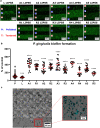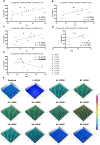Key topographic parameters driving surface adhesion of Porphyromonas gingivalis
- PMID: 37741851
- PMCID: PMC10518006
- DOI: 10.1038/s41598-023-42387-5
Key topographic parameters driving surface adhesion of Porphyromonas gingivalis
Abstract
Dental implant failure is primarily due to peri-implantitis, a consequence of bacterial biofilm formation. Bacterial adhesion is strongly linked to micro-/nano-topographies of a surface; thus an assessment of surface texture parameters is essential to understand bacterial adhesion. In this study, mirror polished titanium samples (Ti6Al4V) were irradiated with a femtosecond laser (fs-L) at a wavelength of 1030 nm (infrared) with variable laser parameters (laser beam polarization, number, spacing and organization of the impacts). Images of 3-D topographies were obtained by focal variation microscopy and analyzed with MountainsMap software to measure surface parameters. From bacteria associated with peri-implantitis, we selected Porphyromonas gingivalis to evaluate its adhesion on Ti6Al4V surfaces in an in vitro study. Correlations between various surface parameters and P. gingivalis adhesion were investigated. We discovered that Sa value, a common measure of surface roughness, was not sufficient in describing the complexity of these fs-L treated surfaces and their bacterial interaction. We found that Sku, density and mean depths of the furrows, were the most accurate parameters for this purpose. These results provide important information that could help anticipate the bacterial adhesive properties of a surface based on its topographic parameters, thus the development of promising laser designed biofunctional implants.
© 2023. The Author(s).
Conflict of interest statement
The authors declare no competing interests.
Figures





References
-
- Spriano S, Yamaguchi S, Baino F, Ferraris S. A critical review of multifunctional titanium surfaces: New frontiers for improving osseointegration and host response, avoiding bacteria contamination. Acta Biomater. 2018;79:1–22. - PubMed
-
- Moraschini V, Poubel LADC, Ferreira VF, Barboza EDSP. Evaluation of survival and success rates of dental implants reported in longitudinal studies with a follow-up period of at least 10 years: A systematic review. Int. J. Oral Maxillofac. Surg. 2015;44:377–388. - PubMed
-
- Schwarz F, Derks J, Monje A, Wang H-L. Peri-implantitis. J. Periodontol. 2018;89:S267–S290. - PubMed
-
- Arciola CR, Campoccia D, Montanaro L. Implant infections: Adhesion, biofilm formation and immune evasion. Nat. Rev. Microbiol. 2018;16:397–409. - PubMed
Publication types
MeSH terms
Substances
LinkOut - more resources
Full Text Sources
Molecular Biology Databases

